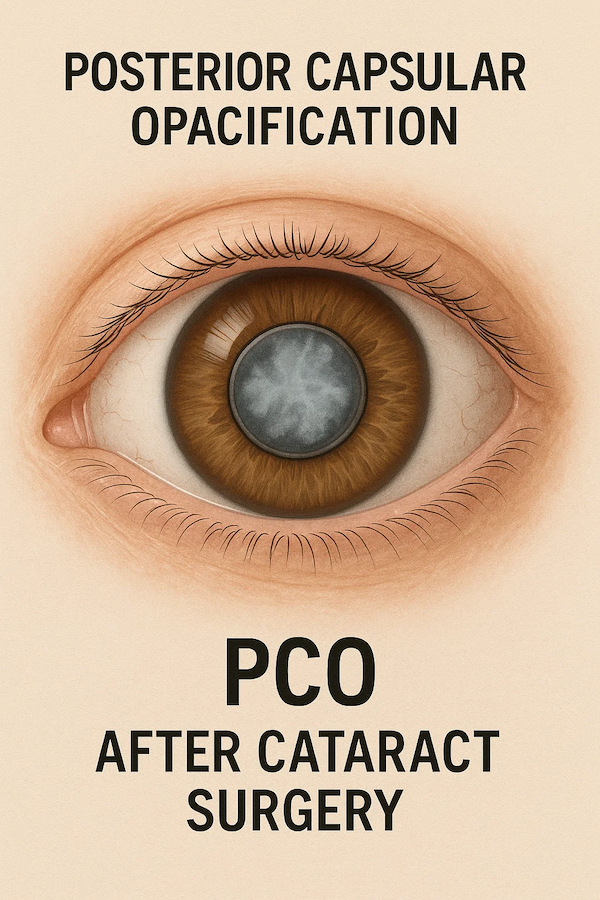If your vision starts to look cloudy again after cataract surgery, you might wonder, “Did my cataracts come back?” The answer is no — what you may be experiencing is posterior capsular opacification (PCO), sometimes called a secondary cataract. It’s the most common complication after cataract surgery, and it happens when the clear capsule holding your new lens becomes hazy over time. The reassuring news? PCO is highly treatable. With a quick, painless outpatient procedure called a YAG laser capsulotomy, your vision can be restored almost immediately.

Some cataract patients who’ve had an intraocular lens (IOL) implanted during cataract surgery may experience a phenomenon known as posterior capsule opacification (PCO). PCO has similar cloudy vision symptoms as cataracts, making it worrisome for those who’ve recently had surgery. PCO is often referred to as secondary cataracts because the symptoms are similar. However, the posterior capsule is not a cataract.
Understandably, that information is probably confusing. Rest assured, we’ll provide answers that should help clear things up.
What Is Posterior Capsule Opacification?
After cataract surgery, some patients may develop a complication called posterior capsular opacification (PCO). This happens when the thin membrane (capsule) that holds the artificial lens implant becomes cloudy over time. Because this clouding can cause blurry vision similar to cataracts, PCO is often referred to as a “secondary cataract.” While it may feel concerning if your vision becomes hazy again after surgery, it is a common condition and can be treated quickly and effectively with a YAG laser procedure.
Posterior capsule opacification is common after cataract surgery. About one in five patients will develop PCO within a year of having cataract surgery. After five years, around one-third of patients will experience PCO.
Many patients confuse posterior capsular opacification with a cataract returning.
Here’s how they differ:
| Feature | Cataracts | Posterior Capsular Opacification (PCO) |
|---|---|---|
| What it is | Clouding of the eye’s natural lens | Clouding of the capsule that holds the artificial lens after cataract surgery |
| When it develops | Before cataract surgery, usually with age | Weeks, months, or years after cataract surgery |
| Common symptoms | Blurry/cloudy vision, glare, faded colors, trouble seeing at night | Blurry or hazy vision returning after surgery, glare, halos around lights |
| Also called | Cataract | “Secondary cataract” |
| Treatment | Cataract surgery to replace the cloudy lens | YAG laser capsulotomy — a quick, painless outpatient laser procedure |
| Outcome | Clear vision after surgery with an artificial lens | Clear vision restored almost immediately after YAG laser |
What Causes PCO After Cataract Surgery?
During cataract surgery, the cloudy natural lens is removed and replaced with an artificial intraocular lens (IOL). The thin capsule that once held the natural lens is left in place to secure the new one. Over time, some residual lens epithelial cells may grow on the back of this capsule. This growth creates a cloudy film, reducing visual clarity — a condition known as posterior capsular opacification (PCO).
Factors that may increase the risk of PCO include:
- Younger age at the time of surgery
- Certain eye conditions (e.g., uveitis, diabetes)
- Surgical technique or type of IOL implanted
- Natural healing responses that stimulate cell growth
This clouding may develop weeks, months, or even years after surgery, leading patients to ask: “What causes posterior capsular opacification, and why does my vision seem blurry again?”
Symptoms of Posterior Capsular Opacification
Posterior capsular opacification is often called a secondary cataract because the symptoms can feel almost identical to cataracts. In both cases, the clouding makes it harder for light to reach the retina, which affects how clearly you see. If you’ve had cataract surgery and notice your vision becoming less sharp again, you may be experiencing PCO symptoms, such as:
- Blurry or hazy vision that seems to return after surgery
- Increased glare or halos around bright lights
- Trouble seeing in low-light conditions
- Difficulty driving at night due to poor contrast and glare
These changes can be frustrating, but the good news is that PCO is highly treatable and vision can be restored quickly.

Can Posterior Capsular Opacification Go Away on Its Own?
No — posterior capsular opacification (PCO) does not go away naturally. Once the capsule behind the lens implant becomes cloudy, it stays that way until treated. If symptoms such as blurry vision, glare, or trouble seeing at night begin to affect your daily life, the only solution is a quick outpatient procedure called a YAG laser capsulotomy, which can safely restore clear vision.
How Do You Treat Posterior Capsular Opacification?
The most effective treatment for posterior capsular opacification (PCO) is a simple outpatient procedure called a YAG laser capsulotomy. During this treatment, your eye doctor uses a focused laser to create a small opening in the cloudy capsule behind your lens implant. This clears the pathway of light to the retina, restoring sharp vision.
A YAG laser capsulotomy is:
- Quick — usually taking only a few minutes
- Painless — no incision or stitches are required
- Effective — most patients notice clearer vision almost immediately
This safe and reliable procedure has become the gold standard for PCO treatment, helping patients return to the clarity they enjoyed after cataract surgery.
Can Posterior Capsular Opacification Be Prevented?
While posterior capsular opacification (PCO) is common after cataract surgery, there is no guaranteed way to prevent it. However, advances in surgical technique and the design of modern intraocular lenses (IOLs) have helped reduce the risk. Your surgeon may select an IOL style that makes cell growth on the capsule less likely, which can lower the chance of developing PCO. Even so, some patients will still experience clouding months or years after surgery. The reassuring news is that if PCO does occur, it can be treated quickly and effectively with a YAG laser capsulotomy.
How Common is Posterior Capsular Opacification?
Posterior capsular opacification (PCO) is the most common complication after cataract surgery. Studies show that about 1 in 5 patients may develop PCO within the first year, and roughly one-third will experience it within five years. While these numbers may sound concerning, it’s important to know that PCO is not harmful to the eye and is highly treatable with a quick YAG laser procedure that restores clear vision.
When Should You See a Doctor for PCO?
You should contact your eye doctor if you notice your vision becoming cloudy, blurry, or hazy again after cataract surgery. While posterior capsular opacification (PCO) is common and highly treatable, it’s important to rule out other possible eye conditions that may affect your vision. An eye exam can confirm whether PCO is the cause and, if so, your doctor can recommend a simple YAG laser procedure to restore clarity. Don’t wait — seeking care promptly ensures your eyes stay healthy and your vision remains sharp.

Treatment for Posterior Capsule Opacification
If posterior capsular opacification (PCO) is making your vision cloudy again, the most effective solution is a quick outpatient procedure called a YAG laser capsulotomy. During this treatment, your surgeon uses a precise laser to create a small opening in the cloudy capsule behind your lens implant. This allows light to pass through clearly — without the need for stitches or an incision.
The procedure is painless, takes only a few minutes, and most patients notice an improvement in vision almost immediately. Best of all, YAG laser capsulotomy is typically covered by medical insurance. If PCO symptoms are interfering with your daily life, don’t wait — clear vision is just one simple treatment away.
Does Posterior Capsule Opacification Worsen Over Time?
Yes, your posterior capsule opacification symptoms can get worse over time. As the lens capsule gets cloudier, you’ll experience diminished vision, similar to the way it was when a cataract was present. If you’ve recently had cataract surgery and started noticing vision problems, contact your eye doctor about treatment. They’ll help determine what treatment is right for you.
Read More: What Can Cause Loss of Eyesight?
Ready to See Clearly Again?
If you’ve noticed cloudy or blurry vision after cataract surgery, you don’t have to live with it. At ClearChoice Laser, our experienced eye doctors specialize in diagnosing and treating posterior capsular opacification (PCO) with quick, painless YAG laser procedures. Schedule an appointment today and take the first step toward restoring the clear vision you deserve.
Sources Cited
Raj, S. M., Vasavada, A. R., Johar, S. R. K., Vasavada, V. A., & Vasavada, V. A. (2007, December 3). Post-operative capsular opacification: A Review. International Journal of Biomedical Science: IJBS. https://www.ncbi.nlm.nih.gov/pmc/articles/PMC3614664/
Koviak, K. (2015, March). Posterior capsule opacification. Michigan Medicine. https://www.med.umich.edu/1libr/Ophthalmology/Cornea/PosteriorCapusleOpacification.pdf













